|
< Earlier Kibitzing · PAGE 1 OF 2 ·
Later Kibitzing> |
| Jun-10-05 | | babakova: In this game I like Reshevskys determined play on the queenside, which he follows up with a nice weaking of the kingside 20.Bg5! etc. The move I like the most however is 32.h4! which is incredibly profound. It covers g5 an extra time and prepares to swing the knight to f4. 29.Be3! is also a cute positional move which prepares Ng5 and puts pressure on blacks weakened queenside. Quite a good game. |
|
| Jul-20-06 | | Maynard5: I agree with the previous comment -- a very good positional game by Reshevsky. Another interesting aspect of the game is that after the knight has reached d5, Black is forced to open lines on the e-file and b-file, after which White penetrates with a decisive attack against the king. |
|
Mar-05-09
 | | Jonathan Sarfati: Very well played by White. His switch to the K-side with h4 was played in severe time trouble as well. |
|
Oct-24-09
 | | wwall: After 35.h5, perhaps better is 35...gxh5 36.Nd5 Nxd5 37.cxd5 Be5. After 38.Bxc5, it looks like 38...Bd4 and 38...Qxc5 loses. 39...Bd4?? looks like the losing move. Perhaps 39...Bf8 (or 39...Rd8) and 40...Qe7 may be better. |
|
| Oct-24-09 | | AnalyzeThis: Playing this eccentric stuff against Reshevsky probably wasn't a good idea, because he didn't know openings anyway. This would have been like a normal game for him, where each move he's just calculating and relying upon his positional understanding to find the best move. |
|
| Dec-04-09 | | Marmot PFL: Keres must have thought he was playing Botvinnik. |
|
Oct-23-10
 | | Fusilli: So, are we to conclude that the queenside fianchetto in the KID is so bad that it is worth a tempo waste (3.d3, 6.d4)? I guess the answer is yes... I have to say I was quite surprised by 6.d4. |
|
| Nov-15-10 | | WhiteRook48: 3 d3???!!! interesting |
|
Sep-03-11
 | | al wazir: How can 24. Nd5 not be good for white? If 24...Bxd5 25. exd5, white has a protected passed ♙. And if the ♕ moves, where can it go? The threats of 26. Rxb6 and 26. Ne7+ rule out practically all squares. If 24...Qa7, then 25. exf5 Bxd5 26. cxd5 gxf5 27. Qb3. Oh, well. Reshevsky won anyway. |
|
| Sep-03-11 | | rilkefan: <<al wazir>: How can 24. Nd5 not be good for white? If 24...Bxd5 25. exd5, white has a protected passed P.> Am I missing something after 25...e4 threatening Qxh2 if the knight moves? |
|
Sep-03-11
 | | perfidious: <al wazir>, <rilkefan> 25....e4 would indeed be very strong, so the knight must be driven back with the preliminary 24.h3, when White keeps some advantage. |
|
| Sep-03-11 | | smirnoff: <3 d3???!!! interesting> 6.d4 means that it was a loss of a tempo only. |
|
| Sep-03-11 | | goodevans: Once 28 Qb3 had been played, my instinct would have been to get my K off the a2-g8 diagonal. If not immediately then shortly thereafter. Keres leaving his K on g8 was significant several moves later in allowing the N to get to d5, triggering black's demise. |
|
| Sep-03-11 | | thegoodanarchist: Lots of maneuvering and positional play and the <BLAMM!> a short sharp combination forces Keres to throw in the towel. I was surprised. I expected a drawn out endgame with pawn promotion themes. |
|
| Sep-03-11 | | kevin86: The end came very fast. White's pieces located behind the enemy forces,are deadly. As for the pun:Who KERES? |
|
Sep-03-11
 | | al wazir: <rlkefan> & <perfidious>: Thanks. Nd5 was lurking in the background but never got a chance to happen. |
|
| Sep-03-11 | | Gregor Samsa Mendel: A Spanish book I have on this match agrees with <wwall> and gives 39...Bd4? as the losing move. It states that 39...Kf8 was necessary. |
|
Sep-03-11
 | | profK: Sammy the Super Solid, and a long reign of being one of the best, but never crowned, A bit like Rubinstein |
|
| Sep-03-11 | | DrMAL: <kevin86: The end came very fast> Black blundered with 39...Bd4? This game was below par for these players IMO, there were earlier opportunities granted by black and missed by white. Also, Keres' play in the end got inaccurate and then (on move 39) fell apart maybe he had time trouble. <WhiteRook48: 3 d3???!!! interesting> That's a bit of punctuation LOL. For a better rendition by black see Petrosian vs Smyslov, 1961 |
|
Dec-07-11
 | | Honza Cervenka: 23.Qb3 Kh8 24.Nd5 looks like a pretty straightforward win for white. Keres did not play the opening very well here, to put it very mildly. |
|
Oct-04-13
 | | WCC Editing Project: From this position (white to move)
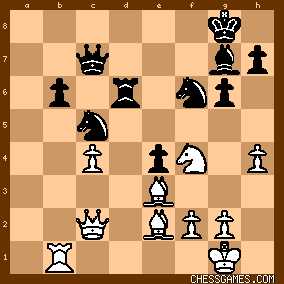
click for larger view<"The last seven moves were made with three minutes remaining on each of their clocks. Here <<<Sammy>>> showed that superiority in time trouble for which he is famous."> -D.A. Yanofsky and H.J. Slavekoorde, "Battle Royal... A Round by Round Account of the Thrilling Contest for the World's Chess Title." "Chess Life and Review" (April 1948), p.11 |
|
Aug-07-20
 | | KEG: A very intense and complex game. All in all, a fine performance by Reshevsky. The game was played in Round 3 of the 1948 World Championship Tournament. At the beginning of this round, Keres seemed poised to make a strong run for the title. He had defeated Euwe in Round 1 and annihilated Smyslov in Round 2. Meanwhile, Botvinnik--after a bye in Round 1--had defeated Euwe in Round 2, while Reshevsky had drawn with Smyslov in Round 1 and had a bye in Round 2. With Reshevsky's win in this game and Botvinnik's draw with Smyslov in the same round, the scores stood after 3 rounds: Keres: 2-1
Botvinnik: 1.5--0.5
Reshevsky: 1.5-0.5
Smyslov: 1-2
Euwe: 0-2
There has been considerable commentary on the game, and it has taken me nearly two weeks to sift through all this literature. In assessing what happened, it must be recalled that Reshevsky and Keres faced brutal time pressure (e.g., they both had under three minutes remaining after move 32 with eight moves yet to play to reach the move 40 time control). In an era in which there were no increments, this was quite terrible time pressure, especially given the complexity of the position. Part of analysis is a search for truth. Thus, Kasparov's analysis of the final moves of the game, which include variations 20 moves deep, are useful theoretically, but hardly something the players could have handled with the clock ticking. Indeed, I fed some of Kasparov's variations to Fritz and Stockfish, each of which consumed more than 3 minutes to make anything like the assessment Kasparov presents. In my own review of this game, I have tried to keep in mind both the theoretical issues discussed at length by Kasparov and others as well as the reality of two humans with limited time trying to prevail in the heat of battle. 1. Nf3 Nf6
2. c4 b6
"An invitation to transpose the game into a Queen's Indian Defense." (Golombek) "Somewhat premature, for generally b6 is fully justified only is Nf3 and d4 have been played already." (Kmoch) 3. d3!

click for larger view"!"--(Keres)
"???!!!" -- (<WhiteRook48>). Since Reshevsky played d4 on move 6, isn't this just a loss of time, as <smirnoff> contends? But the move has both theoretical and psychological points in its favor. On the theoretical front:
"The text is designed to obtain control of e4." (Golombek) "[An] attempt to profit [from] the prematurity of b6...If White makes any other move first (usually g3 etc.) then Black can prepare for d5 which gives him sufficient counterplay in the center. Here things are a little bit more difficult for Black in view of the possibility of e4." (Kmoch) "Very interesting: Black goes for the Queen's Indian set-up, which usually leads to a sharp fight for the possession of e4. White immediately settles this fight to his advantage by playing his d-pawn to d3 for the moment, intending not to advance it further until he had taken control of e4." (Euwe) "An interesting opening idea...With the text-move, White exploits the fact that the move b6 does not fit together well with the continuation e5, and therefore White will carry out the e4 advance." (Keres) As the the psychological component of the move, it should be noted that this was only the second time the above-diagrammed position had been reached (the first being in a game between Marini and Eliskases at Mar de Plata 1947. In an age without computed databases, it is doubtful either player knew of the earlier game. Thus, both contestants were thrown back on their own resources, and Keres' superior opening knowledge was blunted: "...Reshevsky is determined to get the opening off beaten tracks to paths where Keres' greater knowledge of opening theory will not matter." (Golombek) "Black is faced with a totally new kind of opening problem, which is not at all easy to solve at the board with a limited amount of time." (Keres)'' "Subtle psychology. Reshevsky immediately diverges from the theoretical oaths, proposing a competition in the solving of non-standard problems directly at the board, which could have proved a difficult task for Keres, who had arrived in an elevated mood [having won his first two games in the tournament] but who had the black pieces." All in all, I really like Reshevsky's choice here, which had the merits of originality, deep strategic themes, and excellent competitive tactics against so fine a player as Keres. |
|
Aug-08-20
 | | KEG: Post II
3... g6
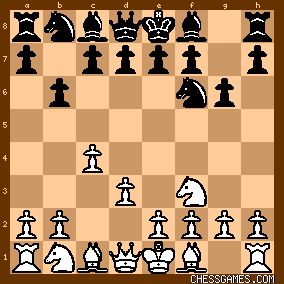
click for larger view"A double fianchetto defence is too much of a luxury...White [now] profits from his advance in development to gain control of the centre.
Instead, Black has at his disposal the simple and good 3...c5..." (Golombek) "Simpler was 3...c5, but Keres doesn't like symmetrical positions." "With this move, Black heads for the King's Indian Defence, where his extra tempo b6 does not have any significant importance. Therefore simpler was 3...c5...Black would achieve strong pressure against White's centre." (Keres) "The best results reaction was natural play in the centre--3...c5...But the leader [Keres] was aiming for more complicated play, and for him a King's Indian set-up (also with an extra tempo!) seemed most appropriate." (Kasparov). 4. e4
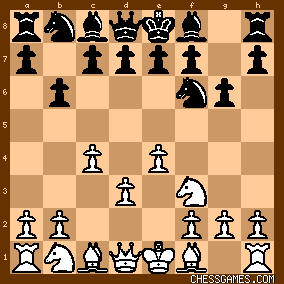
click for larger view"Threatening e5, hence Black's next move." (Golombek) 4... d6
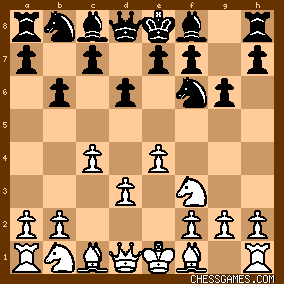
click for larger view"If 4...Bg7 5. e5 Ng4 6. d4 followed by h3 could become awkward." (Keres) "...[picking up on Keres' line and reaching a different conclusion] 6...d6 7. h3 Nh6 8. Nc3 [8. Bd3 looks better, while Golombek's 8. Bf4 allows Black to equalize with ease--KEG] dxe5 9. Nxe5 Bb7 [9...Nf5 is even better--KEG] Black's problems are quite resolvable...." (Kasparov) Kasparov also gives 4...c5 ("!?"--Kasparov) as "beginning an immediate fight for the centre" which he says is a "quite acceptable way of developing." The question in this line is the status of the Black K-side Knight after 5. e5 Nh5 which seems OK after 6. d4 cxd4 7. Qxd4 Nc6 of after 6. Be2 followed by 8. Nc3. 5. Nc3 Bg7
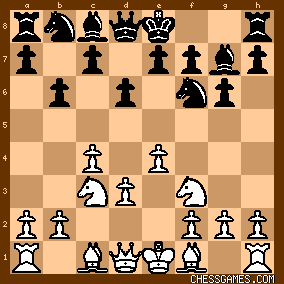
click for larger viewNow came the remarkable follow-up by Reshevsky:
6. d4!
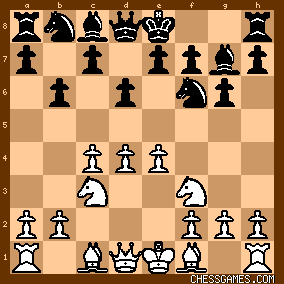
click for larger viewCan White afford this seeming loss of a tempo:
"Reshevsky shows a bold disregard for the elementary principle of opening strategy, that one should never waste Pawn moves, [but does so] in this case with good reason. For we have now arrived at a King's Indian Defence...with the different that Black has in addition played b6. But the Pawn move is quite out of place in the King's INdian, and merely means that Black has weakened his Q side." (Golombek) "It looks as if White has simply lost a tempo for this is the King's Indian Defense with b6 as an extra move for Black. Right--but the extra move means an extra weakness." (Kmoch) "Now a King's Indian has arisen in which Black has gained the move b7-b6. But it is a gain of doubtful value." (Euwe) "This advance, though a loss of tempo, is sooner of later forced if White wants to take up the battle for the centre. The game has now clearly transposed into the King's Indian Defence with the extra move b7-b6 for Black, which...does not offer him any major benefits." (Keres) "This move is necessary, but now play...switches to King's Indian lines, and the tempo spent by Black on b7-b6 does not play any role." (Kasparov) Also important was the psychological strategy of White: "Reshevsky has achieved...success by diverting his opponent from familiar Queen's Indian set-ups and forcing the Estonian grandmaster, a player f classical style, to readjust to a type of opening that he employed rarely." (Kasparov) |
|
| Aug-08-20 | | RookFile: You can say that Reshevsky's d3 and then d4 is a loss of time, and you would be correct. However, black's putting the bishop on b7 was very committal, and with the setup that emerged, white had a positional threat of Nd5. Keres prevented this with ....c6 - which returns the tempo to white, but also leaves the b7 bishop misplaced. |
|
Aug-08-20
 | | KEG: Post III
The machinations described in my earlier posts and the potential weakness created by b6 notwithstanding, Keres' position to this point was at worst only slightly inferior. The question now was how Keres would handle--and how Reshevsky might try to attack--the Black double fianchetto arrangement. 6... 0-0
7. Be2
7. Bd3 looks more to the point, but Reshevsky had decided to build on his small edge slowly and to avoid any theoretical lines that might play into Keres' mental data-base. The position was now:
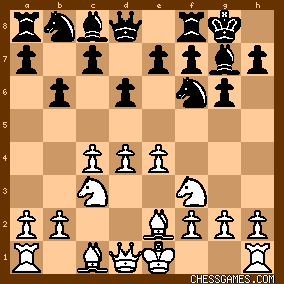
click for larger view7... Bb7
I was surprised to read the criticism of this entirely normal move. Some of the commentators, however, remained so skeptical of the double fianchetto set-up that they recommended dispensing with this seemingly obvious placement of Black's light-square Bishop. Thus, Kmoch preferred 7...Nbd7 followed by e5 and deferring a decision on how to develop the Bishop. Kasparov in this commentary on this game was more emphatic, saying that 7...Bb7 was "not in accordance with the logical development of the black pieces" and recommending instead 7...c5 and if 8. d5 then 8...e6. Kasparov ultimately sought to exploit Black's extra tempo "in a Modern Benoni set-up, where after an exchange of pawns on d5 the [Black] bishop could come out to a6." This approach seems debatable at best. While the White pawns are likely to block the Black Bishop on b7, the pressure on the White center surely counts for something. And as for developing the Bishop on a6, that square might be a useful route for the b8 Black Knight in Kasparov's variation: 7...c5 8. d5 e6 9. 0-0 exd5 10. exd5 Re8 11. Re1 after which most natural for Black seems to be either 11...Bf5 or 11...Na6 followed by 12...Bf5. I am certainly not saying that Kasparov's idea is without merit. But the criticism of Keres' move--or the suggestion that it had much to do with his loss of this game--seems a bit over the top. After 7...Bb7, the position was:
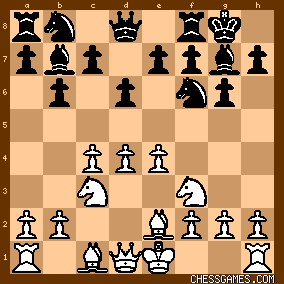
click for larger view8. Qc2
Kasparov praises Reshevsky's patience in declining to play the superficially indicated 8. d5. Indeed, the strengthening of the White center with the text in lieu of 8. d5 e6 9. 0-0 exd5 10. exd5 c6 11. Bg5 cxd5 12. cxd5 (to give just one plausible line after 8. d5) does look like a better approach to the unique opening position in this game. 8... e5
"Threatening 9... exd4 10. Nxd4 Nxe4."
8...Nc6 and 8...c5 were reasonable alternatives. After the text, the position was: 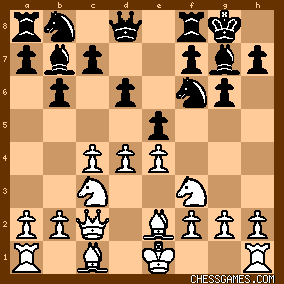
click for larger view9. dxe5
Should Reshevsky instead have played 9. d5? The commentators are divided on this issue. In favor of the text were Kmoch and Keres:
"Very well played." (Kmoch)
"Black's extra tempo in developing the Bishop to b7 at last has the effect that White, in contrast to the normal King's Indian Defence, immediately has to resolve the tension in the center." (Keres) Keres went on to concede that even with the text, White gets no real edge, but argued that 9. d5 Nbd7 followed by Nh5 "would have given rise to a position where Black seems to have the more favorable prospects." Kasparov, Euwe, and Golombek disagree, and prefer 9. d5. After 9. d5, Golombek, like Keres, only considers 9...Nbd7. But the crucial line after 9. d5 is the one given by Kasparov: 9...Nh5 10. g3. Kasparov notes that the resulting position was akin to those handled so superbly by Petrosian, and that White is clearly better. In fact, White has some edge after both 9. d5 and after the text, and the choice is primarily one of style. To the extent there was anything wrong with Reshevsky;s 9. dxe5, it was his questionable continuation on move 10. 9... dxe5
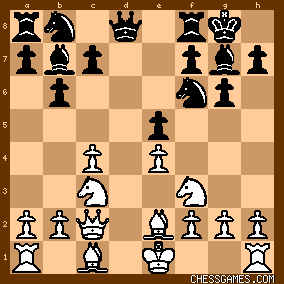
click for larger view |
|
 |
|
< Earlier Kibitzing · PAGE 1 OF 2 ·
Later Kibitzing> |
|
|
|





